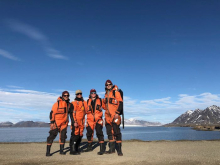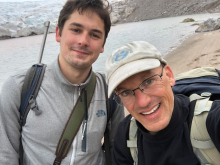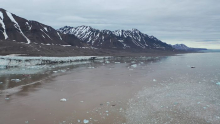Update
We are excited to share this expedition, supported by National Geographic, with everyone! As this is a continuation of teacher Mark Goldner's research experience that started with PolarTREC in 2011, we thought it fitting that he continues to share his experience here and with you. We hope you'll join us!
What Are They Doing?
The Svalbard Archipelago has an arctic climate and is home to several large bodies of ice - alpine glaciers in the mountains, and tidewater glaciers that descend into the sea. Svalbard is currently undergoing rapid climate change with the dramatic retreat of its tidewater glaciers.
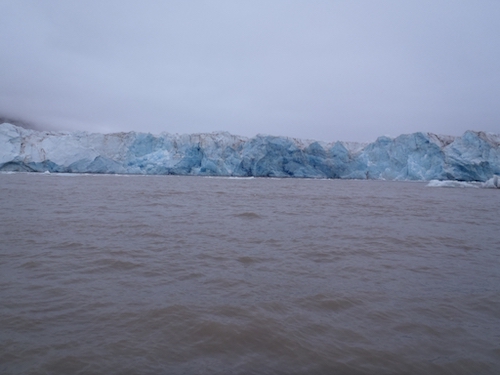
The goal of the research is to gain a deeper understanding of ice-ocean interactions and processes at the faces of tidewater glaciers. This important research will increase our knowledge of climate change and tell the visual story - in particular, this research will further our understanding of ice retreat rates and the impact on sea level rise in the future.
Tidewater glaciers are among the fastest-changing systems in the Arctic, and the dynamic Kronebreen glacier is situated a short distance from the scientific research base of Ny Ålesund at 79°N latitude. In particular, the team will investigate how climate change affects sediment transport and deposition associated with the tidewater glaciers, icebergs, meltwater streams, and marine currents.
The summer ice mélange at the ice face in these smaller systems is flushed out rapidly making it possible to work safely from small boats at a distance (between 200m to 2 km) from the calving ice face. Our proposed work follows on our earlier observations that warm North Atlantic Water is impacting the ice face more today than seen in 2005, 2009, 2011, and 2014, increasing retreat rates. Over these years, we have observed different meltwater plumes turning on and off on a daily to weekly basis. Funded by National Geographic, we have planned the science to add observations to other aspects of the glacial system being monitored by Norsk Polar scientists (Jack Kohler, Katerine Husmin, et al).
The team will be mapping bathymetry of the ice margin area to compare with earlier surveys, and recording oceanographic data (including temperature, salinity, and turbidity of the water column) to track the inflow of North Atlantic water at the ice face. They are particularly interested in monitoring the position and velocities of subglacial jets as they exit the glacier and enter the fjord. The team will also record and monitor iceberg calving at the glacier face.
Beyond the science, public outreach using science and imagery will be used to communicate to the public critical climate change issues, exposing them to the challenges and rewards of conducting high latitude research. Public outreach will showcase arctic processes and how what happens in the Arctic high latitudes impacts coastal resiliency.
Where Are They?
The team works on and around Kongsfjord and its glaciers while working out of Ny Ålesund on western Spitsbergen, the largest island in the Svalbard island archipelago. The Svalbard archipelago is situated in the Arctic Ocean, north of mainland Europe, approximately mid-way between Norway and the North Pole. Ny Alesund, at 79°N latitude, is one of the world’s northernmost settlements and can have a population of up to 120 people during the summer when research is being conducted.
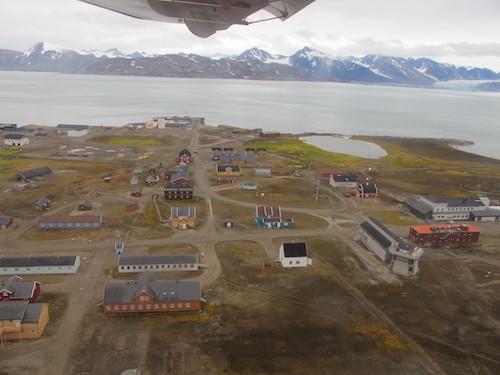
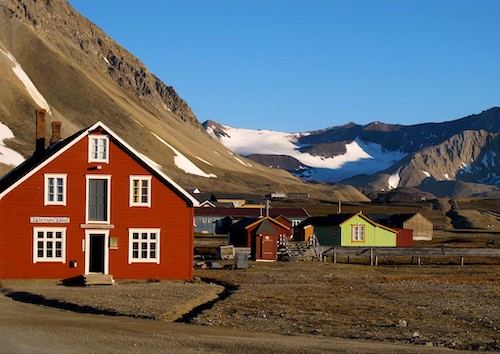
Latest Journals

Dr. Brigham-Grette's research interests are focused on the stratigraphy, sedimentology, and chronology of geologic systems that record the climate evolution and sea level history of the Arctic since the Pliocene. Most of her research program is aimed at documenting the global context of paleoenvironmental change across "Beringia", i.e., the Bering Land Bridge, stretching across the western Arctic from Alaska and the Yukon into NE Russia including the adjacent marginal seas. Starting in the 1980s with fieldwork on the sea level history and glacial stratigraphy of vast Arctic coastal plains and coastal environments in comparison with regional alpine glaciation, she is now focused on the integration of records from marine and lake systems.
Since 1991, her group has participated in numerous field expeditions to remote regions of Arctic Russia and she was co-chief scientist in 2002 of an expedition on the U.S. Coast Guard icebreaker Healy, taking sediment cores from the Bering and Chukchi Seas. She is the US Chief Scientist of the El'gygytgyn Lake Scientific Drilling project, a multinational field program leading to the first unprecedented recovery in 2009 of a 3.6 Myr record of terrestrial paleoclimate. She has previously been involved in the IPY STEM Polar Connections project to integrate the study of polar regions and International Polar Year activities into the middle and high school curriculum from the terrestrial Arctic.

Kelly McKeon is a former Master's student in the Geosciences department at UMass Amherst, and current PhD student in the MIT-WHOI Joint Program in Oceanography, studying sediment transport in coastal environments. Her research incorporates field and laboratory methods to better understand coastal processes as they relate to coastal hazard risk quantification and mitigation in a changing climate. Outside of her research, Kelly is passionate about increasing the accessibility of science for all people, and enjoys volunteering with the Girl Scouts and the New England Aquarium.

Xander is a senior at the University of Massachusetts Amherst studying geology and environmental science. His research focuses on better understanding the hydrogeology of Salar systems in South America and assessing the impact of lithium mining on these complex environments. He is passionate about education and has taught middle school English and earth science. In his free time, Xander enjoys backpacking, biking, and playing basketball.

